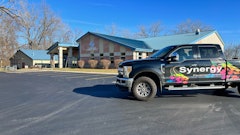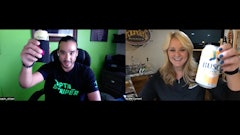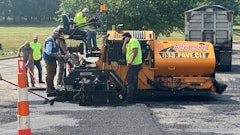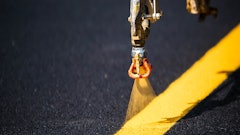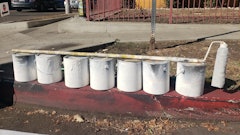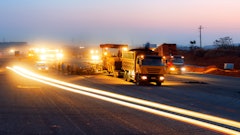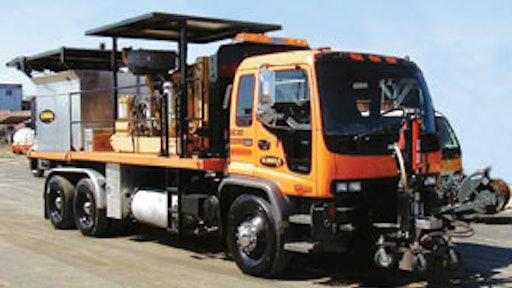
For years, Scotty's Contracting had relied on removable tape to provide temporary lane changes required as part of its work. But workers found that using tape was not only expensive, but problematic.
"Previously, when we used the removable tape for lane switches, the tape wouldn't come up like it needed to," says Kenny Reynolds, project manager with Scotty's Contracting.
"The state (Kentucky) wanted to remove the tape but wouldn't allow us to put darker tape over light tape. And, as was often the case in cooler weather, the tape wouldn't stick to the road surface, which created problems during the project."
As Scotty's Contracting sought out a better alternative to the temporary tape, they decided to use temporary paint striping and a waterjet removal solution provided by Kimbra Inc., Bowling Green, KY, a subcontractor that takes road safety to heart.
Founded in 2003 to provide removal of temporary paint used during highway maintenance projects, Kimbra works in conjunction with striping companies, who provide the temporary painting, while Kimbra provides the paint removal.
"Safety is our biggest concern," says Kim Bryant, president of Kimbra. "I was in an accident that left me paraplegic; I see the importance of road safety and strive to improve it. If we can save one life by improving highway construction methods that make roadways safer, we have met our goal."
For years, contractors have relied on removal methods such as grinding and the use of temporary tape for creating temporary lanes during road construction projects, both of which have challenges associated with their use. With grinding, the machine can leave small depressions in the road surface or can leave "ghost marks" and confuse drivers if all reflective marking is not removed.
Temporary tape can cause problems getting the tape to stick to the pavement and, depending on the conditions, removing the tape once lanes need to be moved or opened. Costs increase due to the cost of the tape and the additional time spent rerouting traffic during construction.
Kimbra's removal process uses a customized waterjet machine mounted on a truck that blasts the paint off the road surface in a sweeping motion without leaving any marks. At the core of this system is a 40,000-psi, 6.5-gpm Husky ultra-high-pressure waterjet pump, developed by Flow International Corp.
Kimbra and its customers have found that using the waterjets for removal of temporary painted lines is a safer, faster, more economical method and eliminates the need for tape on road maintenance projects.
One of Kimbra's first projects was Kentucky's I-65 North freeway project for Scotty's Contracting, which was a success on all fronts.
"The paint is much cheaper than the temporary tape, which runs around $1.20 to $3 per foot," says Bryan Simpson, project manager at Kimbra. "Using temporary paint and waterjetting to remove the paint, we've helped customers cut their project costs up to half while providing a much safer environment for both workers and driver."
And it's quicker.
"Using our truck-mounted waterjet removal system, we've found that we're able to remove approximately 50 to 55 feet of paint per minute, depending on the thickness of the paint, asphalt type, and road conditions," Simpson says.
As a result of the temporary paint striping/waterjet removal process, Scotty's was able to save time and money during the I-65 North job.
"Our costs add up in not only materials, especially the cost of the tape, but also in what the state charges us to slow and reroute traffic during maintenance projects," says Reynolds. "Previously, we were spending $1,500 per hour to slow the traffic for lane changes, which took about three to four hours to complete a few thousand feet of lane changes, for a cost of about $4,500 - $6,000.
"Using the paint striping and waterjet removal method, it now takes us 15 minutes to complete the lane changes, which drops our cost down to a few hundred dollars. Using the waterjets, the paint comes up very fast, which is critical because in our business, we're all about speed and efficiency of completing projects."
Both Simpson and Reynolds also laud the safety of paint over tape as another reason they made the switch.
"Using the truck-mounted system is much safer than having a worker walk along to apply and remove tape — with no guarantee that the tape will stick or removal process will work," Simpson says.
"Now, during road construction projects, we paint the temporary lanes and don't have to worry about the lines since they will stay in place on the ground while we work," Reynolds says.
Richard Schmid is surface preparation market manager at Flow Control International Corp.
Selection Tips: How to Choose a Pressure Washer
How do you choose a high-pressure washer? Keith A. Price, vice president, sales and marketing, Hotsy Corp., says ask these questions:
What are you cleaning? If you're cleaning engines, automotive parts, or anything else with oil or grease, consider a pressure washer that generates hot water. Like the dishes in your sink, hot water cuts grease and grime; cold water only pushes it around. If you're simply blasting away soil, caked-on mud, or stripping paint, a cold-water pressure washer will work just fine (80% of pressure washers purchased are of the cold-water variety). A cold-water pressure washer with the right detergent often can solve most cleaning problems.
Where are you washing? Is portability important? Are you cleaning on a job site or do you have easy access to electricity? Do you need a pressure washer with wheels so you can move it around, or are you cleaning equipment and vehicles that can be moved up close to your pressure washer? If you're cleaning indoors, you're limited to using an electric motor to drive the high-pressure pump. The electric motor limits your portability because you're constantly "tethered" to an electrical outlet. If you need hot water indoors, you're further restricted to the type of heating fuel you can use because of fumes from fossil fuels. You can use electricity (expensive), natural gas (requires hard plumbing and must be vented to the outdoors), or LP gas (liquid propane).
If you're cleaning outdoors, you can buy a pressure washer powered by electricity or gasoline, the two most popular power sources. Typically, electric-powered models are more economical, but gasoline-powered pressure washers are more portable (no electric cord). For outdoor cleaning with hot water, you can heat the water with diesel (the most popular), kerosene, or fuel oil in addition to the "indoor energy sources" of electricity, natural gas, and LP gas. The most popular outdoor hot-water pressure washers are powered by electricity (economical) and heated by diesel (economical and plentiful). However, another outdoor hot-water model that is quickly gaining in popularity is one that is powered by gasoline (economical and plentiful) and heated by diesel. Speaking of water, pressure washers typically are fed by a garden hose from a spigot. However, most pressure washers are also capable of drawing water from a large tank or bladder, which makes on-site cleaning possible and eliminates the need to be "tethered" to a faucet.
How long will you be cleaning? If you are operating a pressure washer for less than five hours per week, you will probably be satisfied with a less expensive model available in catalogs and do-it-yourself stores. But don't count on much service or warranty support.
If you are operating a pressure washer from five to 20 hours per week, you will find some mid-range models that are typically identified by a direct-drive pump and a bare-bones design. For those who are serious users —washing for more than 20 hours per week — you will be dollars ahead to invest in quality.
Under Pressure: Making Buying Decisions
- Belt-drive or direct-drive? A high-pressure pump is driven by an engine or motor. Direct-drive pumps, which turn at up to 3,600 rpm, are more compact, keeping weight and cost down. A belt-drive pump, configured with a pulley and belt, turns the pump at a slower rate (usually 1,500 rpm). Keith A. Price, vice president, sales & marketing, Hotsy Corp., says today's direct-drive pumps have been engineered to hold up very well, even under constant use. The weakness, of course, is that a pump turning at 3,600 rpm will wear out faster than a pump that turns at 1,500 rpm.
- Tri-plunger or axial pump? A tri-plunger pump is turned by a crankshaft, connecting rods, and three ceramic plungers. Price says the rotary design of the axial pump is known for being low cost but higher maintenance.
- High pressure or high volume? There is more cleaning power in a pressure washer's volume (gallons per minute) than in its pressure (pounds per square inch). A pressure washer with 2 gpm and 3,000 psi won't clean as fast as a pressure washer with 4 gpm and 2,000 psi. The first delivers 6,000 cleaning units (2 x 3,000) vs. 8,000 cleaning units (4 x 2,000) in the second.
- Check engine/motor size? Review the flow rate along with the engine or motor size. For industrial cleaning, you want a pressure washer with at least 4 gpm driven by an engine with a minimum of 11 hp (5 hp for electric motor).
- Is the hose of high quality? High quality hoses are made of a rubber compound reinforced with steel wire. A hose rating should be imprinted on the hose itself. A single-wire hose (R1) is typically rated for up to 3,000 psi while a double-wire hose (R2) is usually rated for 4,500 psi or higher.











